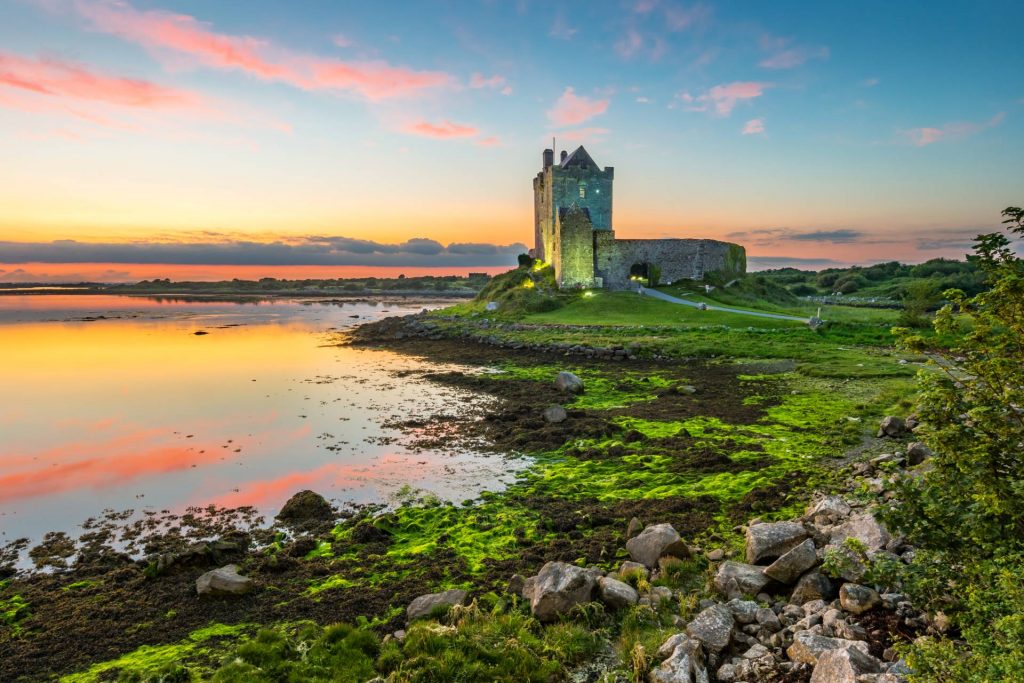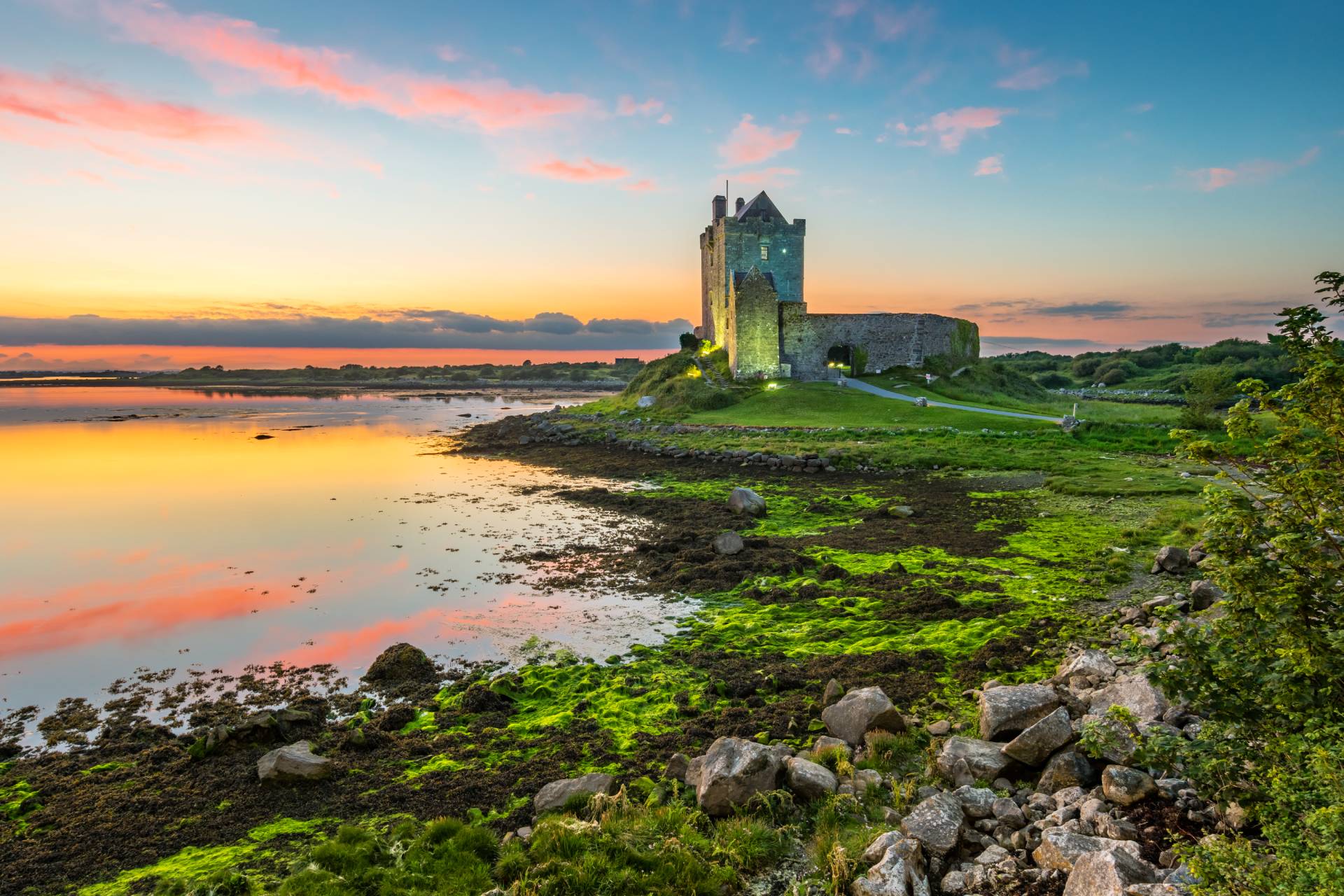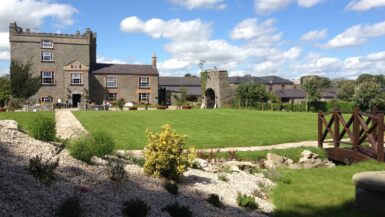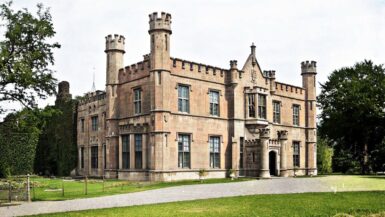Dunguaire Castle stands as a prominent 16th-century tower house located on the southeastern shore of Galway Bay near Kinvara, in County Galway, Ireland. This castle, named after the legendary King Guaire of Connacht, encapsulates a blend of architectural beauty and historical depth, making it a significant cultural landmark in Ireland.
Contents
History of Dunguaire Castle
Construction and Initial Purpose
Dunguaire Castle was constructed in 1520 by the Ó hEidhin (O’Hynes) clan, a powerful family in the region of Uí Fiachrach Aidhne in County Galway. This clan had historical ties to the area dating back to the early medieval period. The castle’s name, Dunguaire, originates from the nearby ancient fort of King Guaire, the generous king of Connacht, lending a legendary aura to its foundation.
Architectural Style and Early Enhancements
The castle is a fine example of a 16th-century Irish tower house. It features a 75-foot high tower and an enclosed defensive bawn with a fortified wall. Originally, these structures were designed to provide security against raids and feuds, which were common in Ireland during this period. The tower house itself was constructed to serve both residential and defensive purposes, with thick stone walls and limited access points to deter attackers.
Transition of Ownership to the Martyn Family
In the 17th century, the castle passed from the Ó hEidhin clan to the Martyn family, one of the Tribes of Galway. This transfer marked a significant shift in the castle’s role from a clan fortress to a more administrative and residential estate. Richard Martyn, Mayor of Galway in the early 1640s, was a notable figure during this period. He made several modifications to the castle, potentially including the addition of the gatehouse and expansion of living quarters to accommodate his family and the administrative needs of his office.
Literary and Cultural Revival
The 20th century brought new life to Dunguaire Castle when it was purchased in 1924 by Oliver St. John Gogarty, a prominent figure in the Irish Literary Revival. Gogarty, who was a close associate of James Joyce and served as an inspiration for the character of Buck Mulligan in Joyce’s Ulysses, used the castle as a summer residence and a gathering place for literary figures. Under his ownership, Dunguaire Castle became a hub for cultural and intellectual gatherings, hosting such luminaries as W.B. Yeats, George Bernard Shaw, and J.M. Synge.
Restoration and Public Opening
After Gogarty’s tenure, the castle changed hands several times before being purchased by Christobel Lady Ampthill in 1954, who undertook further restoration work. Her efforts preserved much of the castle’s historical integrity while making it suitable for public visits. In 1979, Shannon Development acquired Dunguaire Castle and developed it into a key tourist attraction, offering guided tours, medieval banquets, and various cultural events that echo the castle’s storied past.
Significant Historical Figures
- King Guaire: The legendary king of Connacht, known for his extraordinary generosity, provides the historical and mythical backdrop to the castle’s significance in the region.
- The Ó hEidhin Clan: As the original builders and longtime residents, their legacy is integral to the historical narrative of the castle and the surrounding lands.
- Richard Martyn: His contributions during the 17th century reflect a pivotal time in Galway’s history, intertwining the castle’s fate with the city’s political and economic developments.
- Oliver St. John Gogarty: Beyond his political and literary contributions, Gogarty’s stewardship of Dunguaire Castle marked a period of cultural resurgence and preserved the castle as a meeting place for some of Ireland’s greatest literary figures.
Architectural Features of Dunguaire Castle
Design and Structure
Dunguaire Castle epitomizes the typical Irish tower house design that was prevalent among the gentry during the 16th century. The structure is distinguished by its 75-foot (23 meters) high tower, which is a common feature in Irish castles built for both defense and as status symbols. The tower includes four stories, each serving distinct functions ranging from storage and servants’ quarters at the bottom to family living spaces higher up, culminating in the great hall at the top where gatherings were held.
The tower’s base is made of thick stone walls, designed to withstand sieges and provide insulation. Narrow slit windows were strategically placed to offer archers defensive positions while minimizing external vulnerabilities. The entrance to the tower was typically raised, accessible only by a removable ladder or staircase, which could be secured in times of attack.
Defensive Walls and Bawn
Surrounding the tower is a bawn, an enclosed courtyard with a defensive wall. The bawn was integral to the castle’s defense strategy, providing a first line of security. It typically contained outbuildings such as stables, kitchens, and workshops essential for the day-to-day functioning of the castle. The gatehouse, added in the 17th century by the Martyn family, was another critical feature, enhancing the entrance’s security and showcasing the family’s wealth and architectural taste.
Architectural Styles
The architectural style of Dunguaire Castle is predominantly Norman, a reflection of the Anglo-Norman influence in Ireland during the medieval period. This influence is evident in the robust, practical design elements like the round arches and the use of locally sourced limestone, which was both durable and readily available in the region.
Major Restorations and Additions
Throughout the centuries, Dunguaire Castle has undergone several significant restorations and additions that have both preserved and altered its original design:
- 17th Century Additions: Under the ownership of the Martyn family, the castle saw the addition of the gatehouse and possibly the expansion of the bawn wall, which were typical of the architectural adaptations of the period to increase comfort and security.
- 20th Century Restorations: When Oliver St. John Gogarty acquired the castle, he initiated a series of restorations that were crucial in preserving the castle’s structural integrity and historical character. These efforts were continued by Christobel Lady Ampthill, who bought the castle in 1954 and further restored it to its former glory, ensuring that the medieval character was maintained while making the castle suitable for public visits.
- Modern Day: The management under Shannon Development in the latter part of the 20th century marked another phase of restoration, primarily aimed at making the castle a viable tourist attraction. This included safety modifications, structural reinforcements, and the addition of visitor amenities without compromising the castle’s historical essence.
Literary and Cultural Significance of Dunguaire Castle
Role in the Irish Literary Revival
Dunguaire Castle’s significance in the context of the Irish Literary Revival is profound. The revival, a movement spanning the late 19th and early 20th centuries, aimed to promote Irish literature and celebrate Celtic heritage, and the castle served as a pivotal meeting point for many of the era’s key figures. Under the ownership of Oliver St. John Gogarty, who purchased the castle in 1924, Dunguaire became synonymous with the cultural rejuvenation of Ireland. Gogarty himself was a significant literary figure, poet, and close friend of many prominent writers and intellectuals of the time.
The castle’s atmospheric and historic backdrop provided inspiration and a venue for literary gatherings, discussions, and creative expression. These interactions were instrumental in fostering a sense of Irish identity and cultural pride, which were central themes of the revival.
Notable Literary Figures and Artists
Several luminaries of Irish literature and arts graced Dunguaire Castle, contributing to its storied legacy as a cultural hub. Among them were:
- W.B. Yeats: Perhaps the most notable figure associated with the Irish Literary Revival, Yeats visited Dunguaire Castle and participated in discussions that helped shape modern Irish literature. His passion for Ireland’s mythic past and its cultural regeneration found a resonant setting in the castle.
- George Bernard Shaw: Shaw, the renowned playwright and critic, also spent time at Dunguaire. His interactions here were part of the broader intellectual exchanges that characterized the revival period.
- J.M. Synge: Best known for his play “The Playboy of the Western World,” Synge was another key figure in the revival and a visitor to the castle. His works often explored themes of Irish rural life, which dovetailed with the ambiance and setting of Dunguaire.
- Lady Gregory: An influential dramatist and Yeats’ close collaborator, Lady Gregory was deeply involved in the revival’s efforts to promote Irish folklore and literature. Her visits to Dunguaire Castle underscored its importance as a literary salon.
Cultural Events and Gatherings
The castle not only hosted individual artists but also served as the venue for numerous cultural events and literary meetings. These gatherings were informal salons where ideas flowed freely, fostering a creative synergy that influenced many literary works of the time. The tradition of hosting artistic gatherings continued even after Gogarty’s time, maintaining the castle’s role as a cultural beacon.
Tourism and Public Access
Visiting Hours and Tours
Dunguaire Castle is open to the public from April through October, welcoming visitors to explore its historical and architectural splendor. The castle offers daily guided tours that provide insights into its rich history, architectural details, and the prominent figures who have graced its halls. These tours typically run every half hour and are available in multiple languages to accommodate international visitors.
Seasonal Events
One of the highlights of visiting Dunguaire Castle is the opportunity to participate in medieval banquets. Held in the evenings from April to October, these banquets recreate the convivial atmosphere of a 16th-century feast, complete with period costumes, traditional music, and theatrical performances. The banquets are a unique way to experience Irish cultural heritage firsthand.
Getting There and Ticketing
Dunguaire Castle is conveniently located near the picturesque village of Kinvara, just a short drive from Galway City. It is easily accessible by car and public transport, with ample parking available for visitors. Tickets for entry and for the medieval banquets can be purchased online in advance, which is recommended during the tourist season to ensure availability.
Educational and Community Involvement
Educational Programs
The castle runs a variety of educational programs aimed at schools and youth groups. These programs are designed to educate students about Ireland’s medieval history, the Irish Literary Revival, and the castle’s role in both. Workshops and guided tours are tailored to be age-appropriate and can be aligned with the educational curriculum.
Cultural Events and Community Engagement
Dunguaire Castle serves as a venue for various cultural events throughout the year, including poetry readings, musical evenings, and historical reenactments. These events not only attract tourists but also engage the local community, making the castle a central part of cultural life in the region.
Current Management and Future Plans
Current Management
As of the last available information, Dunguaire Castle is managed by Shannon Heritage, a company specializing in the management and development of historical and cultural sites across Ireland. Shannon Heritage is known for its emphasis on preserving the historical integrity of sites while making them accessible and engaging for modern audiences.
Future Plans
While specific future plans for Dunguaire Castle are not always publicly detailed, the management typically aims to continuously improve the visitor experience and educational offerings. This includes the restoration of architectural features, the enhancement of visitor facilities, and the expansion of event programming. Additionally, there may be ongoing discussions or plans for local government involvement or new partnerships to further enhance the site’s impact and sustainability.
These efforts ensure that Dunguaire Castle remains not only a preserved historical site but also a vibrant center of cultural and community activity, contributing significantly to the local heritage and tourism sector.







Leave a reply